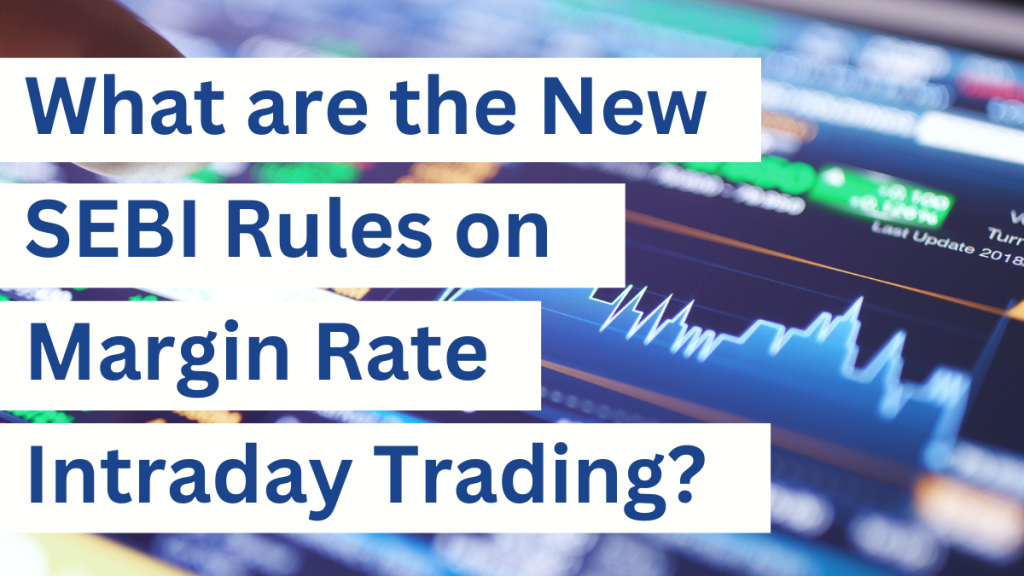The Securities and Exchange Board of India (SEBI) stands as the key regulator of India’s stock market, ensuring fairness, protecting the interests of investors, and maintaining market stability. SEBI is pivotal in setting the rules for how much money traders need to have upfront for day trading, aiming to reduce risk and prevent the misuse of borrowed money. Recently, SEBI has updated its regulations concerning the margin requirements for intraday trading, impacting both traders and financial institutions significantly. In what follows, we shall examine in detail the specific SEBI regulations that govern margin requirements for intraday trading within India. These rules strive to forge a more equitable trading landscape for investors and the marketplace at large.

What are Intraday Trading and Margins?
Intraday trading forms a fast-paced and engaging sector of the stock market, where traders buy and sell assets all within the same day. This approach stands apart from the more conventional strategies that favor holding investments over a lengthy duration. Envision a lively market scene, with stock values constantly ticking higher or lower – this is where intraday traders excel. They closely examine market trends, news events, and various indicators to spot brief opportunities for profit.
Here’s where the concept of margin comes into play, acting as a pivotal tool for intraday traders. Since their strategies hinge on capturing minor price shifts, optimizing buying power is essential. Here, margin works like a power boost for your capital. Let’s dive deeper.
Margin essentially permits you to borrow money from your broker to purchase a greater quantity of shares than your capital alone would allow. Think of it as a leverage mechanism. You put up a portion of your own funds, which is the margin requirement, and the broker provides the rest. This grants you control over a larger stake in a specific stock, potentially enlarging your profits.
For instance, if you anticipate a slight increase in a stock’s price throughout the day, but your funds limit you to acquiring only a handful of shares, the potential earnings might seem insignificant. However, using margin, you can secure a larger number of shares, thus magnifying your gains if the price rises as expected. Imagine purchasing 10 shares with your capital versus securing 50 shares through margin. A modest price increase across 50 shares results in a significantly larger profit than with just 10 shares.
Margin can be very potent, yet it carries inherent dangers. While it can boost your winnings, it can equally expand your losses. Should the stock’s value move contrary to your assumptions, you might incur considerable losses beyond your original stake. The borrowed money from the broker must still be returned, and losses can deplete your capital much faster than trading solely with your funds.
Intraday trading thrives on fleeting price shifts and demands swift decision-making. Margin is crucial as it allows traders to manage a larger position and possibly secure substantial returns. Nonetheless, the perils tied to margin are equally critical to acknowledge. Grasping these nuances is paramount prior to diving into the dynamic realm of intraday trading.
SEBI’s New Rules on Margin Rate Intraday Trading
Now that we have an idea on what intraday trading is and what role margin plays in it, we will be better able to understand the new rules SEBI has issued. The new changes are as follows:
In December 2020, the Securities and Exchange Board of India (SEBI) implemented a new rule that significantly impacted intraday trading (buying and selling stocks within the same day). This rule involved a gradual decrease in the amount of money, called margin, required to buy stocks for intraday trading.
Previously, before December 2020, traders typically needed the full value (100% margin) of the stock upfront to purchase it intraday. SEBI’s new rule changed this by reducing the margin requirement by 25% every three months. This meant by June 2021, the minimum margin needed had dropped to 75%. Ultimately, by around September 2021, the margin requirement for intraday trading reached 0%.
As of September 2021, SEBI regulations limit the intraday margin provided by brokers to a maximum of 5x the initial investment.
SEBI has also set a new limit on leverage at 20% of the total VAR and ELM. This rule combines two key measures: Value at Risk (VAR) gauges the potential max loss for your day trade, while Extreme Loss Margin (ELM) serves as an extra safety layer imposed by SEBI. ELM tackles unexpected risks beyond what VAR accounts for, providing a buffer for losses that surpass the VAR estimate.
Let us understand this through an example. Let’s say that you are considering planning to buy shares valued at ₹100 for a day trade. Under the previous 100% margin rule, you needed the entire ₹100 in your account. Now, following the new regulation, the broker calculates the VAR and ELM for the desired shares.
Suppose the combined VAR + ELM amounts to ₹50. With the 20% limit in place, the highest leverage your broker can extend is 20% of ₹50, meaning ₹10. So, the broker now locks just ₹10 (20% of VAR + ELM) from your account upfront, rather than demanding the full ₹100 as before. This change frees up ₹90 (your money) to invest in the shares.
Another rule by SEBI regarding intraday trading has been that brokers can now create a lien on the shares within the trader’s demat account. Before, to use shares as collateral, traders had to transfer them from their Demat account (where they hold shares electronically) to the broker’s account.
This transfer process could be inconvenient and potentially risky. Now with SEBI’s new rules, brokers can create a lien on the shares within the trader’s demat account. A lien essentially gives the broker a legal claim on the shares as security for the loan they provide (margin).
For additional security, before the broker can actually use the pledged shares (by pledging them to the clearing corporation), they need to get a one-time password (OTP) from the trader. This extra step verifies the trader authorizes the use of the shares.
Overall, these changes make the process of using shares as collateral more convenient and secure for both traders and brokers.
The final new rule by SEBI on intraday trading is that intraday profits can only be used for trading activities two days later. SEBI restricts traders from leveraging profits earned through same-day stock transactions (intraday trading) for additional purchases on that day. Consequently, this enforces a mandatory two-day clearing phase for such profits.
What do these New Rules Mean for Traders?
Leverage, the process of using borrowed funds to increase purchasing power, is now set at a much lower limit. This reduction constrains traders’ buying capacity compared to before, likely reducing profits but also limiting losses. It prompts traders to pursue more cautious tactics, focusing on secure, high-quality opportunities with minimal risk.
Margin requirements for day trades now merge Value at Risk (VAR) and Extreme Loss Margin (ELM). This method creates a flexible system that modifies margins based on the specific stock and current market state, aiming to lower risks linked to very unpredictable stocks. Furthermore, the implementation of VAR and ELM could push brokers towards greater openness regarding the risks tied to particular trades.
Traders have the option to pledge shares in their demat account as collateral without the need to physically hand them over to the broker. This method eases the procedure and minimizes the chances of mistakes or delays. Despite this, brokers are allowed to mark these shares to answer any margin calls when necessary. This strategy provides brokers with some level of security while keeping things convenient for traders.
A significant update limits the usage of earnings from intraday trading. Such profits are now accessible for trading only after two days. This rule hampers strategies that depend on quick reinvestment of capital. Traders might need to adapt by retaining more liquid assets and planning their trades with more lead time.
These reforms are designed to cultivate a more equitable trading environment by possibly reducing undue leverage and risky trades. They encourage careful, risk-adjusted trading tactics, aiming for a more stable and less volatile market. Although traders used to depend on high leverage and frequent trades might feel the impact, these new guidelines could advantage the marketplace at large.
By now you must have understood the iron grip that SEBI has on the trading and finance sector of India. Several people looking to make their mark in finance choose to join SEBI as professionals. SEBI conducts annual exams like SEBI Grade A to recruit such individuals. ixamBee helps you prepare for lucrative job roles in SEBI through our SEBI online course and other practice materials like SEBI important questions in exams, mock tests, and more.
Conclusion
These SEBI regulations aim to foster ethical trading behaviors, contributing to a more stable trading landscape. By grasping these rules and aptly managing risks, day traders can venture into the stock market with increased assurance.
This initiative by SEBI underscores the importance of prudent trading practices, thereby safeguarding the market’s integrity. Day traders, equipped with a deep understanding of these guidelines, are positioned to navigate the complexities of the market more effectively. Engaging with these protocols not only enhances individual trading strategies but also contributes to the overarching stability and fairness of the financial market.
Remember, a commitment to continual learning and adherence to regulatory frameworks is fundamental for sustained success in trading. Encountering the dynamic nature of the stock market with an informed perspective fosters a responsible trading environment. For those who endeavor to stay at the forefront of regulatory compliance, consulting legislative bodies and regulatory authorities remains an essential practice.
To help you prepare 50% faster for competitive exams, ixamBee provides a free Mock Test Series and all the Current Affairs in English and Current Affairs in Hindi in the BeePedia capsules for GA Preparation. You can also get the latest updates for Bank PO, Bank Clerk, SSC, RBI Grade B, NABARD, and Other Government Jobs.
Also Read:
The Importance of SEBI for the Stock Market
The Role of SEBI in Ensuring Secure Investments
SEBI Grade A Study Plan 2024: A Journey towards becoming a SEBI Grade A Officer







![List of Mountains in India [Updated] copy of blog news](https://www.ixambee.com/blog/wp-content/uploads/2020/03/Copy-of-Blog-new-5-100x70.png)





